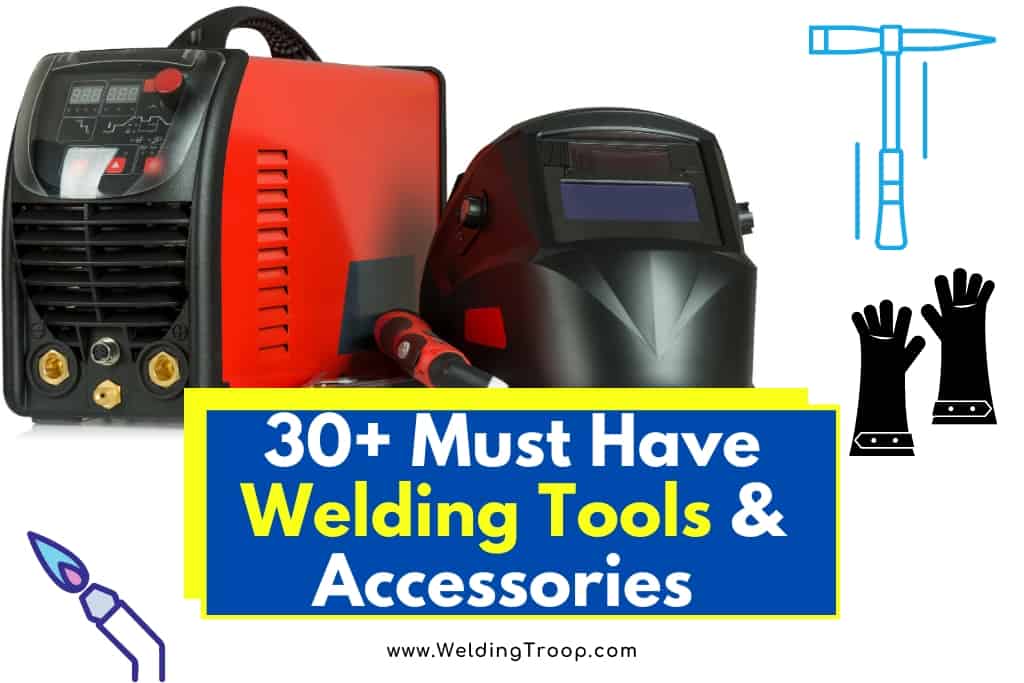Looking for welding accessories? Interested in welding equipment near you or your area? Where to find the best deals on welding tools online in 2021?
Look no more!
We found the best welding Accessories out there.
We recommend only the welding Accessories and welding tools we love and use. NO CRAP
Everything from best TIG welding machine welders, gas welding to pliers. From torch accessories to pipe clamp.
You’re just moments away from the perfect welding accessories!
Welding is a very lucrative profession that also allows you to express your creativity. If welding is done incorrectly, it can be a very dangerous job but staying safe is quite simple if you learn the rules and obey them every time. Fortunately, there are tools and accessories that can make your next welding job both more efficient and a lot safer.
If you’re new to welding and hope to eventually have your own business, there are tools that are considered a must to accomplish that goal. If you make a list of these tools, setting up your workplace is much easier because you won’t overlook anything important, and whether you want these tools for your own business or even when you work for someone else. Listed below are 30+ “must-have” welding tools and accessories that every welder must have:
Since this is a large guide, here’s a clickable index to help you navigate:
Table of Contents
Welding Accessories and Welding Tools: A Complete List
1. Welding Helmet
Not all welding helmets are alike, and you no longer have to pay a fortune to get the right one. Welding helmets with solid shades are sometimes tough to see through and may cause your welds to be misplaced.
This is especially true when you’re new to welding, but an auto-darkening helmet gets rid of that problem. Auto-darkening helmets allow you to see your workpiece easily so that your work is more efficient.
I recently wrote an article on this subject, have a look at it: How To Choose A Welding Helmet: What To Consider
Because you can see exactly where all of the pieces are, you can work on the exact spot you need to work on, providing you with much less frustration in the end.
Recommended by: “Spartan”
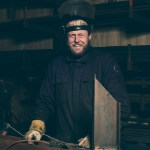
“If you’re seeing spots after a weld, then bump it up a half shade or so at a time until you are no longer seeing spots and that should be the sweet spot for that process. If you are still having trouble seeing the puddle at a 9 or so, it may just mean it is time for a better helmet…if you can’t see the puddle, you won’t be able to make good welds.“
2. Jacket
A welding jacket is a must for this occupation because it keeps the body well protected against metal splatter and high heat as you’re welding. Always made out of fire-resistant materials, it is made to protect the wearer from anything that might happen while welding.
3. Ear Protection
Not only is welding loud but you are exposed to this loudness for long periods of time, which means that ear protection is crucial. Always use ear protection that is made for extra-loud noises that you’ll have to put up with for a long time.
4. Grinding Visor
Lightweight but strong, this type of visor is worn each time that you’re grinding an item because this grinding can easily result in all types of flying debris that can be both sporadic and very dangerous. Grinding visors, in other words, keep you much safer as you do your job.
5. Welding Magnets
These are heavy-duty magnets that you use to hold metals firmly on the surface you are working on. Naturally, they are not the same as magnets that you buy at the hobby store; they are much stronger and a lot more efficient than regular magnets.
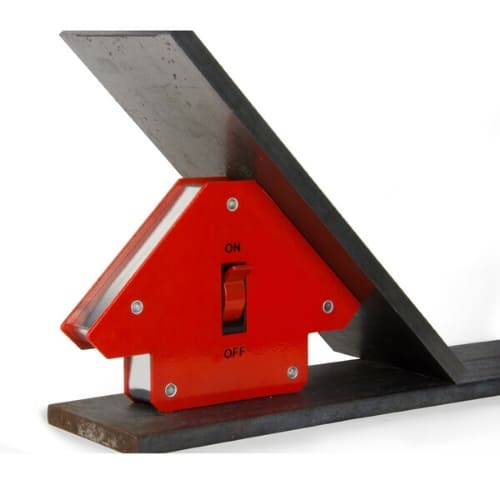
They come in different sizes and designs. If you’re going to buy welding magnets, make sure you buy them in all sizes to accommodate all of your welding projects. They can be small, large, or somewhere in between, and you can find them anywhere welding supplies are sold.
Since you’ll likely need so many of them, especially in the beginning, you should look for places that offer the products at discount prices.
Read next: Can You Weld Magnets? Or Would It Ruin Them?
6. Welding Framing Jig
Although not a necessity for beginning welders, the right framing jig makes it easy to create square frames. To do this, all you have to do is put two end pieces into the jig and tighten it up before making your tack welds.
Getting the perfect 90-degree angle has never been so easy, but you can also take a few C clamps and produce the same results if you prefer, saving yourself some money in the process.
Because steel can warp when it’s welded, you can save yourself a lot of time, not to mention a lot of frustration, by buying a welding framing jig. It is a great addition to your welding collection.
7. Speed Square
A good speed square is a welding tool you’ll likely use frequently. Its main purpose is to mark your spot on long pieces, such as square tubing, that indicates where the piece should be cut whenever you want to shorten it. Let’s say you want to shorten a piece of tubing and cut off 12 inches so you can have a perfect 90-degree angle.
The speed square shows you right where to cut the piece to make this happen. You can cut pieces at 45-degree and other angles as well, but the speed square allows you to “mark the spot” where the cutting should occur so that you get the results you want in the end.
8. Sheet Metal Gauge
When you’re working on a welding project and you need to know the thickness of a piece of metal to set it correctly before you start welding, a sheet metal gauge can give you the exact thickness of the piece so that you don’t have to eyeball it and guess at it.
Once you are finished with several projects and you have left-over pieces of metal hanging around, it will be impossible to remember how thick each of them is, which is why you need a sheet metal gauge.
If you slide the openings of the gauge over your workpiece, the gauge gives you an exact measurement. This means your project is guaranteed to turn out just right, making this a very handy tool indeed.
For more info, read this article.
9. Metal File
Metal files are both extremely valuable and very inexpensive, which leaves you with no excuse not to get yourself some. They are used mostly when you’re finishing up a project and when you want those ends and edges to be as smooth as possible.
For bigger pieces, your welding grinder can do this job, but for smaller pieces that have a lot of fine details in them, your metal file works much better.
Metal burns occur when you start cutting your project, and a good metal file will get rid of them and make your product look neater and cleaner. A metal file is simply a great investment because you’ll likely use it quite often.
10. Welding Clamps
When welding two large pieces of metal together, you often need to hold them together so that the job is a lot easier. This is what welding clamps are used for and they are used in conjunction with locking clamps to make sure that the job is done right.
Even for beginners, at least 10 welding clamps should be in your collection of welding tools because you will end up using every one of them. In fact, many welders find themselves using several of these clamps at a time with certain projects.
When you’re welding, the resulting warpage can throw off your project so that it isn’t correctly done, but when you use clamps, they will hold your pieces together tightly so the project comes out just right. The best way to use clamps is to cut your pieces to the right length, make sure the pieces are together tightly, clamp them in place then tack-weld them, then remove the clamps and lay your final welds.
11. Welding Gloves
Gloves made just for welding have heat-resistant linings and come in two types: MIG and stick gloves and TIG gloves. Both of these types are specifically made to keep you safe while welding and are available in many different designs, sizes, and materials.
Welding gloves can be thick or thin, but at least in the beginning, you’ll want the extra-thick ones. You can wear these to pick up hot metal pieces for a few seconds at a time, and you can pick up numerous pieces of hot metal as well.
Since the temperature at the arc can reach 10,000 degrees, your welds are definitely going to give off heat, which is why the right gloves are so important. Thin leather gloves are great for TIG welding because they give you a more precise hold, but start out with thick ones in the beginning until you get used to the art of welding.
Recommended by: “Heavy Hitter”
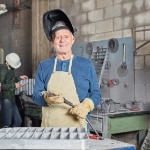
“I don’t always wear both gloves just so I can feel the filler rod. I like the thinner tig gloves but there is nothing that says you must use thin gloves over regular welding gloves.
Well, today, while I was welding using one glove to hold the torch, I went to set the torch down to move some metal around for welding, the torch got away and I grabbed it with my bare hand on the cup. I’m here to tell y’all that it didn’t take to long to realize that damned thing is heavy. Made a quick trip for the liquid soap and cool water. IF my bride is talking to me (after the face cream ordeal) I will have to ask her if we have any cider.”
Related reading: Choosing Welding Gloves: The Only Guide You´ll Ever Need
12. Metal Brush
For any welding project that produces slag, you’ll need a top-notch metal brush. Scraping off slag is much easier with a metal brush, and chipping hammers are also good for this purpose.
Your welding surface has to be as clean as possible before you start working on it, and a heavy-duty wire brush made out of steel is the perfect tool for doing just that.
During many welding projects, a slag coating is created because it acts like a shielding agent. You also have to protect your weld puddle from atmospheric contamination. Your welds remain clean whenever you’re using shielding gas, but you need a metal brush so that you can get rid of the slag produced by your project.
13. MIG Pliers
MIG pliers actually have several different purposes, and since MIG welding is the easiest type of welding for beginners. MIG welding requires a good pair of MIG pliers because they can perform the following tasks:
- They can help you replace your contact tip so you can put a new one in. They have a built-in circular clamp that you can use to screw the tip so that you can replace it.
- You can use the circular clamp to remove the nozzle from your gun. The nozzle is usually very hot and therefore, the circular clamp allows you to remove it without getting burned.
- Your wire stick needs to be a certain length and no more, and your MIG pliers will make sure you get the correct wire stick-out every time.
Finally, since MIG pliers are needle-nosed, you can use the tip of them to clean the inside of your MIG nozzle so that the weld spatter is removed. Since the gas flows out of that nozzle, it needs to be clean at all times.
14. Soapstone
Simply put, soapstone is a marking tool that is used when you’re welding. Soapstone is especially good when you’re cutting pieces into shapes because you can simply mark on the metal pieces so that you know exactly where to cut afterward. It is essentially a type of chalk that you can use to mark lines on the metal so that you know exactly where to place the torch when you’re done.
15. Angle Grinder
Angle grinders have a few different purposes, including removing any excess material from a piece you’re welding and also polishing or cutting different types of metal. Angle grinders are high-quality tools that serve a very important purpose.
Angle grinders are an absolute must when you’re a beginner, and the best thing to do is have two of them on hand at all times: one for grinding and another one for cutting. In fact, you really can’t get by without this tool because of its versatility.
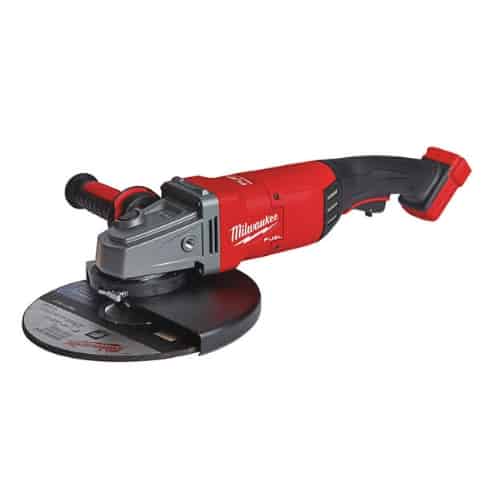
Different devices go on top of the grinder for different functions and tasks. For instance, you can attach a wire brush if you want to remove paint, a grinding disk so that you can smooth out your projects, a flap disk when you want more precise grinding, and a cut-off wheel when you need to cut metal. Angle grinders, therefore, are very versatile and useful tools.
16. Safety Glasses
Protecting your eyes is essential when you’re welding because those tiny sparks you see flying all over the place are actually tiny pieces of metal, so you can imagine what they would do to your eyes if they got near them. When you use angle grinders, for example, it’s very possible that you’ll see tons of these sparks throughout the entire project.
For most welding projects, either a good set of safety glasses or a grinding face shield is imperative because both of these products protect your eyes like nothing else will. After all, sparks can do a lot of damage when you’re grinding or cutting, making safety glasses something you’ll regret not using.
Recommended by: “Tweake The Welder”

“Both heat and optical generation occurs when welding. The right safety glasses can protect you from both. In some circumstances, you can even use safety glasses in place of a helmet but only if no severe sparking is possible.“
17. C Clamps
C clamps are simple to use but perform a very important job: they make sure your workpiece is secured tightly to your work table so that nothing goes awry as you’re welding. In fact, 5 to 10 C clamps are always recommended, and maybe more, because you’ll use them a lot more frequently than you might realize.
Indeed, when you start your project and your pieces aren’t clamped down properly, they can slip out of place without you realizing it, which means the final product won’t be the right size or design. For peace of mind and a lot less frustration, have a lot of these C clamps on hand all the time.
18. Portable Band Saw
Okay, this one isn’t an absolute must when you’re a beginning welder, but it sure makes your welding jobs a lot more accurate and efficient.
It does this because your pieces will be very clean-cut and therefore won’t need as many reworks, which saves you tons of time in the end. The only thing you have to be aware of is that the blade will occasionally need to be replaced because it gets too dull to continue to work with it, but it is both easy and inexpensive to do this.
When you have material that you want to cut to length, portable saws can truly be miracle-workers.
19. Chipping Hammer
A chipping hammer is mostly used to chip away the slag, which makes for much cleaner and neater projects every time. If you’re participating in MIG welding and you’re using flux core wire, or you’re participating in stick welding, you have to consistently chip away at the slag coating because otherwise, you won’t be able to see the weld underneath.
Recommended by: “Plantwelder”

“When you need to remove welding slag and spatter found along the sides of your welded pieces, you need a chipping hammer. Indeed, these hammers make cleaning up as you go along a breeze and they are real time savers.”
20. Oxy-Acetylene Setup
This is a very versatile and useful piece of welding equipment, but it is also the most dangerous tool in your entire welding shop. Therefore, you have to use all of the proper safety equipment each and every time you use it.
With this tool, you can cut perfect circles and bend half-inch steel plates to 90 degrees, as well as many other tasks. It is made to weld, cut, and bend various pieces, so you’ll be using this setup for dozens of projects. Although a MIG welder can do some of these things and is easier for beginners to work with, you’ll eventually want an oxy-acetylene setup so you can do even more.
Related reading: Difference between Plasma Cutter and Oxy-Acetylene Torch Cutter
21. Steel-Toe Work Shoes
You may not think about it but welding can be dangerous on your feet because things can fall on them at any time. This is why heavy-duty shoes or boots with steel in the toes are a must. This footwear is also easily found in most shoe stores.
22. Fire Extinguisher
Though you may not think of a fire extinguisher as a welding tool, it’s imperative that you have one nearby whenever you’re welding. With sparks and fire constantly in the area, you need a high-quality fire extinguisher for when things go awry.
23. Welding Machine
If you love welding, it’s a good idea to have a welding machine in your home. There are many different types of welding machines so do your research and make sure that you get the one that is most appropriate for your needs.
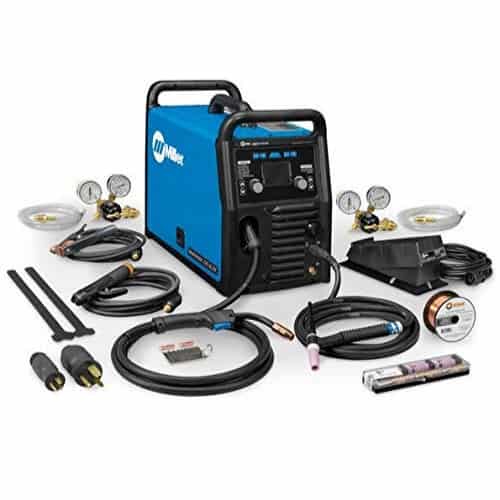
Related reading: Portable Welding Machine: Buyer´s Guide: 5 Things To Look For
24. Table or Cart
When you’re a welder, you need a sturdy cart or table to put your welding machine on so that you can be comfortable. Make sure that the one you choose has wheels to make movement easier and is very stable as well.
Relate reading: Why do Welding Tables have Holes? Tips And Tricks You Need To Know
25. Marking Tools
Marking tools can include soapstone for use on metal, a scribe to mark the metal before welding it, or even a permanent marker if these two items are not available. These are inexpensive but very valuable tools for welding.
26. Welding Wire
When you weld two pieces of steel together, you can use welding wire to make seams that go in between those two pieces. Welding wire is a metal rod that you first heat with high-intensity heat and then melt into these seams before using it on your project.
27. Vice Grips and Pliers
Welders use vice grips and pliers to pick up pieces of metal that are too hot to pick up on your own even when wearing gloves. Some of the vice grips can also be used as clamps when you need to hold two small pieces of metal together.
28. Squaring Tools
Welding pieces at a 90-degree angle can be a challenge but squaring tools are made to make the job much easier. Squaring tools help position the items so that they stay put until the welding is complete.
29. Welding Pliers
Welding pliers are actually six tools in one including a wire cutter, nozzle cleaner, weld splatter remover, chipping hammer, and nozzle and tip installer.
30. Hacksaw
If you find yourself without power for a while, you’ll need a hacksaw. These saws are made to cut metal manually and can be a true lifesaver in certain circumstances.
31. Hand File
Hand files are invaluable because they perform two very important actions. First, they remove any burns that you may have in the metal; second, they do a great job of smoothing ground edges.
Recommended reading
>> How To Start & Grow A Welding Business In 11 Steps
>> Do Welders make Good Money>? – Highest Paying Welding Jobs

